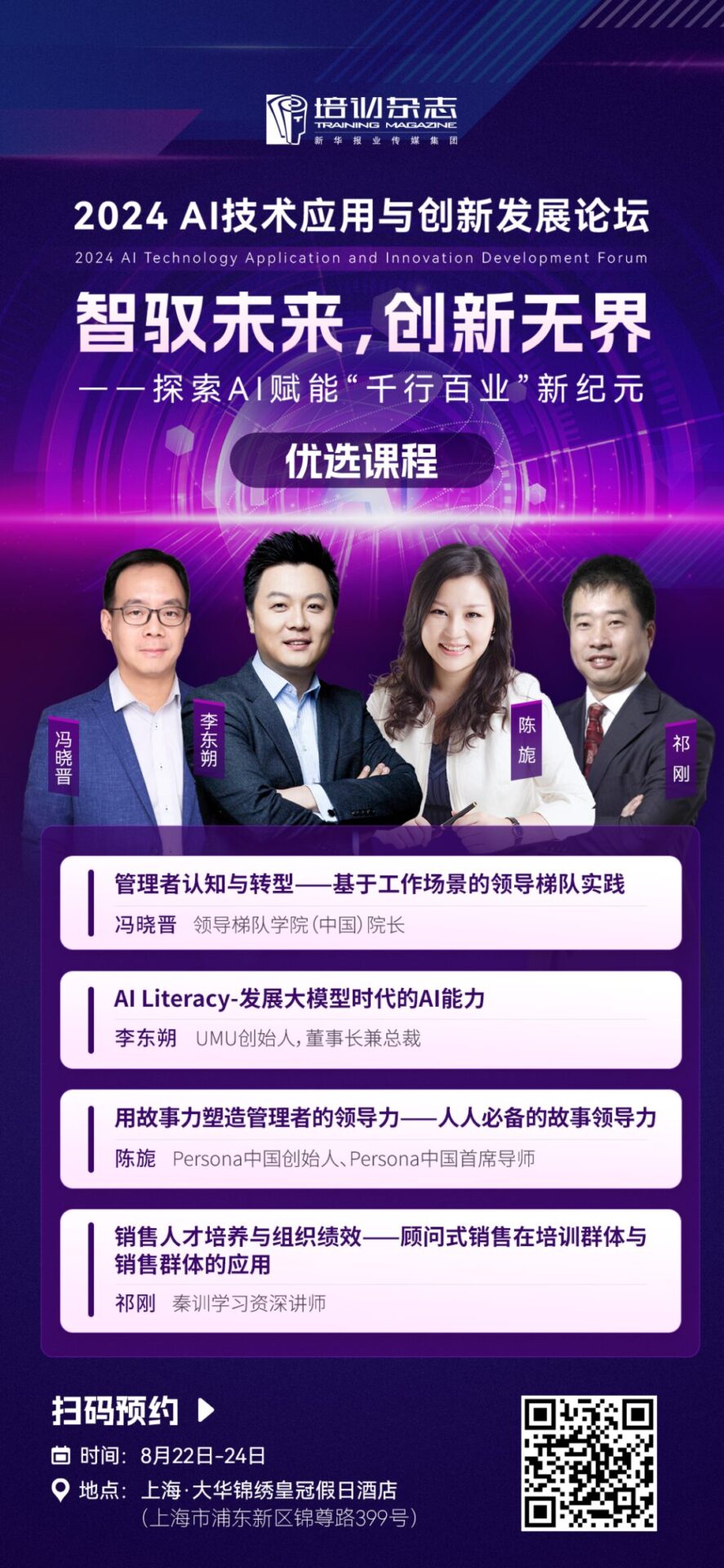
By | Li Dongshuo, Founder, Chairman, and President of UMU
Source | Training Magazine July Issue
It is not easy to elaborate on the definition of Artificial Intelligence (AI). The reason is that AI has the characteristic of phased development, forming new shapes and connotations over time.
Three years ago, when people talked about AI, they mostly discussed machine learning and deep learning, linking it to big data. At that time, organizations used machine learning to improve processes and operations that had not yet been automated or intelligent.
Today, three years later, when people talk about AI again, most of the time they are discussing generative AI based on Large Language Models (LLM).

To explore the opportunities and challenges that AI brings to the training industry, we must first understand its basic concepts. AI encompasses various forms, including analytical AI and generative AI. Among them, the Large Language Models in generative AI are currently the best-performing AI models in the field of general artificial intelligence and language tasks.
According to Accenture, 63% of tasks in the workplace are language-related. Tasks such as writing articles, emails, meeting minutes, and communicating with colleagues and clients all fall under language-related tasks. In industries and positions dominated by knowledge workers, the proportion of language-related tasks is even higher. Therefore, AI large language models have become a common expectation across industries, even being hailed as the “fourth industrial revolution.”

Riding the AI Large Model Fast Train
Helping Organizations Improve Business Outcomes
Recently, during visits to several Fortune 500 companies, it was found that many companies have already provided desktop large model access services for employees. One company introduced AI large models in just three months, which surprised employees but also sent a strong signal: keep up with the AI large model wave immediately.
AI large models are accelerating towards users
Whether it is Google trying to integrate its large model Gemini into the Chrome browser, or Microsoft directly providing CoPilot sidebar services on the desktop, and Apple announcing the integration of OpenAI’s large model services into its smart assistant Siri, providing a localized model with 3 billion parameters that protects user privacy on mobile devices, it is evident that the application scale of AI large models is rapidly expanding globally, aiming to make them accessible to users.
As more individuals begin to use AI large model products and services, it will again drive companies to rethink and upgrade their research and procurement of enterprise-level large model products.
However, companies have higher requirements for the safety, compliance, and controllability of AI large model services, which significantly differs from the privacy terms of large models that serve individuals: the data generated by individual users when using large models may be retrained, and the training results will continue to be provided to unspecified individuals.
Moreover, the generative capabilities of AI large models are highly dependent on the quality of training data. In some critical issues, the answers generated by large models will inevitably rely on the input dataset, thereby affecting the correctness of the answers. Therefore, compliance and algorithm filing for AI large models are key issues that domestic manufacturers need to take very seriously.
AI Large Models Have Penetrated Many Scenarios Across Industries
I believe that in the future, companies will procure or deploy different AI large model services based on their business nature and needs, effectively improving business outcomes on the basis of safety and compliance.
For basic AI large models in enterprises, chatbots are among the more common products. Any employee can chat with the company chatbot at any time, trying to solve work problems while experiencing AI capabilities. Many companies will usher in a wave of usage after introducing basic AI large model services, and then it will settle down. However, in positions with heavier language tasks, large models provide employees with more creative inspiration and significantly enhance their productivity.
For example, a leading global home appliance company has provided its marketing department and store managers with AI large model application products based on text-to-image, hoping that in the near future, both the marketing department and stores can design and produce promotional posters based on prompts without needing to procure related services from third-party suppliers. This is a very pragmatic application scenario that not only reduces the total cost of poster design but also allows for more agile coordination with product marketing plans.
Accenture’s research shows that technology companies have the highest proportion of AI adoption, followed by the life sciences industry. Indeed, many internet companies are providing engineers with AI large model-based interactive coding services, accelerating engineers’ learning and research productivity on new functions and new businesses. The life sciences industry, due to its innovative genes and intense competition, is very determined to introduce AI large model services throughout the lifecycle of new drugs.
Focusing on the field of corporate training, we see that some hands-on trainers have integrated different AI large model services for course development and delivery. The benefit of this approach is that it allows immediate access to the generative and creative capabilities of large models.

Of course, there are some downsides—if internal company data is directly used in “TO C” large model products, the data may not only be retrained but may also be directly searchable by search engines.
It is understood that domestic large model manufacturers have begun to publish the process of user interaction with large models as web pages and have optimized the crawling process of search engines, making users’ interaction content directly exposed in search engine results.
Therefore, we advise trainers to strictly adhere to data boundaries and privacy when using public large model products, and not to provide any information or data involving corporate and personal privacy directly to AI large models. Of course, this also requires companies to accelerate the introduction of compliant large model products and capability building.

Generative AI Large Models
Provide Rich Content for Corporate Training
For corporate training, how can we actively embrace AI large models?
The TPACK (Technological Pedagogy and Content Knowledge) model proposed by American scholars Koehler and Mishra is an important model for thinking about the integration of technology elements in teaching and training, which can provide some inspiration for trainers. Through this model, we can explore and reconstruct the impact and interaction between AI large models as newly emerging technological elements and training systems, training content, and teaching methods.
Generating Training Content, A Strong Capability of AI Large Models
The core capability of large language models in generative AI lies in content generation. Training courses are a typical language task, which perfectly hits the “comfort zone” of large language models. Many people think of using large models to produce course content when discussing the transformation of training scenarios by AI large models.
Currently, the working characteristic of general large language models in the market is to provide summary answers rather than specific content. Summary answers are universal but not accurate. Therefore, if we use them to generate course content, it can guide high school and college students, but there is still a gap in helping college students build professional capabilities, let alone helping enterprises build talent competitiveness.
Based on the DIKW (Data, Information, Knowledge, Wisdom) model (see TIP), we can conclude that enterprises need training content at the level of wisdom and knowledge to help individuals and organizations establish market competitiveness. Simply relying on data and information will make it difficult to achieve training effectiveness and objectives.
TIP DIKW Model
The DIKW model helps people understand the relationships between data (Data), information (Information), knowledge (Knowledge), and wisdom (Wisdom) in knowledge management, illustrating how data transforms step by step into information, knowledge, and wisdom.
The generative training content of large language models includes two aspects: one is the production of content itself. For example, live teaching is a content production process that integrates lecturing and thinking, generating both oral and written forms of content. The former is beneficial for students’ understanding and absorption, while the latter has a higher semantic richness than the former. The advantage of large language models is that they can produce both article-based written content and verbatim scripts based on oral language for trainers to use in teaching or recording.
Therefore, trainers might actively interact with large language models to inspire their thinking and creativity to produce high-quality course content, rather than simply and crudely using large model responses directly as training content.
The second aspect is the production of required forms of training content. For instance, using large language models to generate PPTs, course videos with bilingual subtitles, and even multilingual training content based on the trainer’s voice. Corporate trainers and training institutions can fully utilize AI tools to efficiently complete content production work, thus saving time for other higher-value tasks.
However, it is worth noting that the downside of generation is “hallucination.” In creative work tasks, “hallucination” is a good thing. For example, when writing copy, users may be inspired by large language models to enhance their creativity.
However, for deterministic work tasks, “hallucination” can be troublesome—when people cannot prudently judge the correctness of what the large model generates, it becomes difficult to use them directly as training content.
In the mobile internet era, trainers need to learn how to create H5 courses; in the short video era, everyone has a “digital scissor” to learn how to shoot and edit videos… Although these tasks have certain value, they are not core tasks and belong to low-value necessary logistical work. (Logistics). AI generative large models temporarily relieve trainers from the pressure of needing to learn Python or programming.

Integrating Teaching Methods is Key to Training Applications of AI Large Models
Over the past few decades, the training industry has transitioned from traditional offline training to electronic learning, online learning, and mobile learning. In the shift of training paradigms, training content has been “moved” online and to mobile devices by technology, but constructivist learning methods have not been realized through local area networks, the internet, or mobile internet.
Currently, many companies’ online learning is roughly equivalent to watching video content. Even if learning platforms enhance the liveliness and interactivity of content by adding some fun elements, they still do not achieve a truly constructive learning process and effect.
Inspired by North American video platform Netflix, corporate learning has evolved from Learning Management Systems (LMS) to Learning Experience Systems (LES). Since Netflix can continuously recommend video programs relevant to users based on their interests, corporate learning could potentially achieve a better learning experience following that logic.
However, the result is that, although it solves the content relevance issue, it still does not address the learning effectiveness issue—because the inability to translate learning content into performance and capabilities remains a fundamental bottleneck. Providing training content solely through technology will still lead to the awkward situation of “knowing but not being able to do.”
From the TPACK model, one of the core elements of poor training effectiveness in content-based training is the lack of teaching methods, which is also an urgent issue to be solved in corporate training worldwide.
Thus, one of the key tasks of “AI + Training” is to solve how to effectively apply teaching methods in training scenarios built on new technologies, enabling training to truly produce results.
Looking Forward to New Forms of AI Large Models for Constructivist Learning and Training
According to key theories of learning science, an effective way to make learning effective is practice; and the key way to make practice effective is step-by-step practice, deliberate practice, providing examples, guidance, and discovery. All these tasks seem to be achievable through AI large models, bringing endless imagination for the future of corporate training.
Based on the overall reflection of the TPACK model, people’s expectations of AI and its role in training become clearer.
Specifically, the role of AI large models in corporate training work is first, to use technology to assist in generating creative and non-plagiarized course outlines, reference course content, etc.; second, to use technology to deliver teaching methods that align with learning science, not only moving offline training methods online but also enabling training methods that previously could only be achieved through high-cost human resources, such as one-on-one coaching, anytime feedback, and high-quality structured mentoring, to be realized in a truly digital-native way.
In a paper published in 2013, Professor Qi Qinghua, a member of the American Academy of Arts and Sciences and a professor at Arizona State University, proposed a classic model for evaluating teaching effectiveness—the ICAP model. ICAP represents four modes of learning: Interactive, Constructive, Active, and Passive. Among them, the conversion difference between passive learning and active learning belongs to “input training” and does not yet belong to “output training.” At this point, training is unlikely to achieve the transformation from “knowing to doing.”
In this regard, AI large models should support training courses, helping learners construct knowledge and capabilities, allowing learning outcomes to be effectively applied. Moving forward, the development form of large models is agents. When agents become sufficiently intelligent, they can engage in constructive interactive learning with learners, thus breaking free from the unidirectional, input-based learning.

The Future
May Involve Constant Interaction with AI Large Models
Currently, the global computing power multiplied by algorithmic advancements is iterating at a rate of 40 times per year, even improving year by year. At the same time, AI large model giants are investing hundreds of billions of dollars in the research and iterative development of large models with the vision of general artificial intelligence.
From China to the United States and Europe, hundreds of teams are fully committed to updating and iterating large models, with thousands of scientists simultaneously conducting research in fields such as artificial intelligence, mathematics, linguistics, and computer science.
With such a massive investment in research and development, we have reason to believe that AI large models will continue to improve over time, presenting more intelligent fields and higher levels of intelligence, with the usage duration in enterprises increasing from 15 minutes to 50 minutes, and then to hundreds of minutes. In the future, we may even interact with AI large models constantly.
McKinsey found that organizations successfully applying AI have completely different expectations from those that have not yet adopted it. The former applies AI more to enhance revenue and profits, as well as to establish new business scenarios; the latter still hopes to use AI to reduce costs rather than increase efficiency.

In the wave of transformation brought by AI to enterprises and organizations, corporate HR centers and training departments bear a historic responsibility. AI will not help enterprises and individuals improve productivity and achieve higher income levels simply by being introduced. For training departments, it is necessary not only to enhance their professional quality through AI large models but also to lead organizations in achieving capability transformation with the help of AI.
From information literacy to digital literacy, and then to AI literacy, enterprises and individuals are being propelled forward actively or passively by the times. In the face of this generative AI wave, to develop the AI capabilities of organizations, we should start from the executive level, HR centers, and training departments, achieving results-oriented progress and gradually using AI large models to significantly improve organizational productivity and profits.
OpenAI’s founder Sam Altman mentioned at the beginning of 2024 that moving fast has always been a core value in Silicon Valley. In the era of AI large models, we should accelerate action, seize historical opportunities, and let AI become an important driving force for the rapid development of enterprises.
Training Magazine’s “20” Promotion: At the strong request of readers, we continue to offer limited coupons, first come first served!

On August 23-24, 2024, the “2024 AI Technology Application and Innovation Development Forum” hosted by Xinhua Media Group’s Training Magazine will be held at the Crowne Plaza Hotel in Shanghai. The organizers have selected three experiential courses and one pre-conference workshop, and welcome heads of corporate training departments, training directors, and learning development professionals to register for the conference and book courses (subject to review results).

To meet the needs of our readers,
the Training Magazine video account has launched
2024 China Corporate Training and Development Annual Conference
Highlights Recap Special
For more exciting content,
please follow the “Training Magazine” video account.
This article only represents the author’s personal views and does not represent the position of “Training Magazine”.
For submissions, please contact: [email protected]
|
Previous Reviews |
Creating an Immersive Experience to Inject Vitality into Party Education |
|
Quality Classroom | Hands-on Teaching You to Tackle Problems with Structured Thinking |
|
|
Master the ARCS Model to Manage Online Learning Project Operations! |
|
|
In Corporate Transformation, Training’s Position Can Be Crucial! |